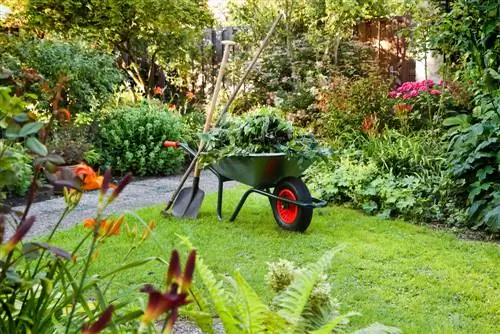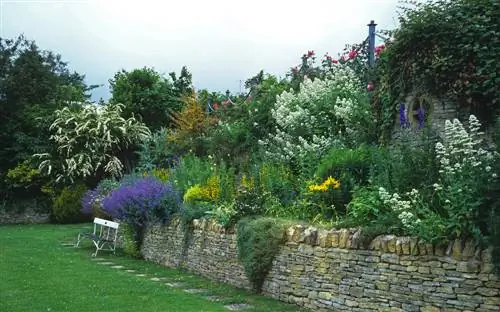- Author admin [email protected].
- Public 2023-12-16 16:46.
- Last modified 2025-01-23 11:21.
Perennial beds are very popular because they require relatively little work. Since the perennials sprout every year, you save yourself having to prepare the bed every year, plant, etc. However, a perennial bed also needs care. Below you can find out which care measures are required at which time of year.

How do you care for a perennial bed at any time of the year?
Caring for a perennial bed varies depending on the season: prepare the soil in spring, remove leaves and fertilize perennials; Water daily in summer, mulch and additionally fertilize heavy feeders; Do not cut back perennials in autumn and winter, cover sensitive perennials and water them even in winter.
Care for the perennial bed in spring
The most important time for care is early spring, before the perennials sprout, i.e. early/mid-March. Here we clean up and prepare the ground so that the perennials can enter the growth phase happily and strengthened. Therefore, in spring you should:
- Remove leftovers, dead leaves and other things from the bed
- cutting down dead plant parts
- remove any frostbitten perennials
- Fertilize perennials with a one to two centimeter thick layer of compost
- dig up and share old perennials
Care for the perennial bed in summer
Summer is the time of flowers and bees. To ensure that the perennials bloom particularly floriferously, it is important to ensure that there is sufficient water supply.
- Water your perennial bed daily on dry summer days, preferably in the morning or evening when it is not yet or no longer so hot.
- Protect the perennial bed from drying out with a layer of mulch. It is best to apply this to the perennial bed in early summer.
Most perennials need very little nutrients to grow well. However, there are a few special cases that are heavy feeders, such as delphiniums, sunflowers or lilies. These need an additional portion of fertilizer in summer. You can find out which perennials you should fertilize and which fertilizer is suitable in this article.
Care for the perennial bed in autumn and winter
Before the first frost, the perennial bed must be winterized. Although most garden perennials are well hardy, winter protection still makes sense in order to keep the perennials safe even in severe frosts.
- Prune your perennials in the falldon't. The dying foliage naturally protects the roots from frost.
- Cover sensitive perennials with brushwood, leaves or a garden fleece.
- Don't forget to water your perennials even in winter. Perennials are more likely to dry out in winter than to freeze.
Tip
In general, perennials do not need to be cut back, as the above-ground parts of the plant die in autumn and the perennials sprout again in spring.






